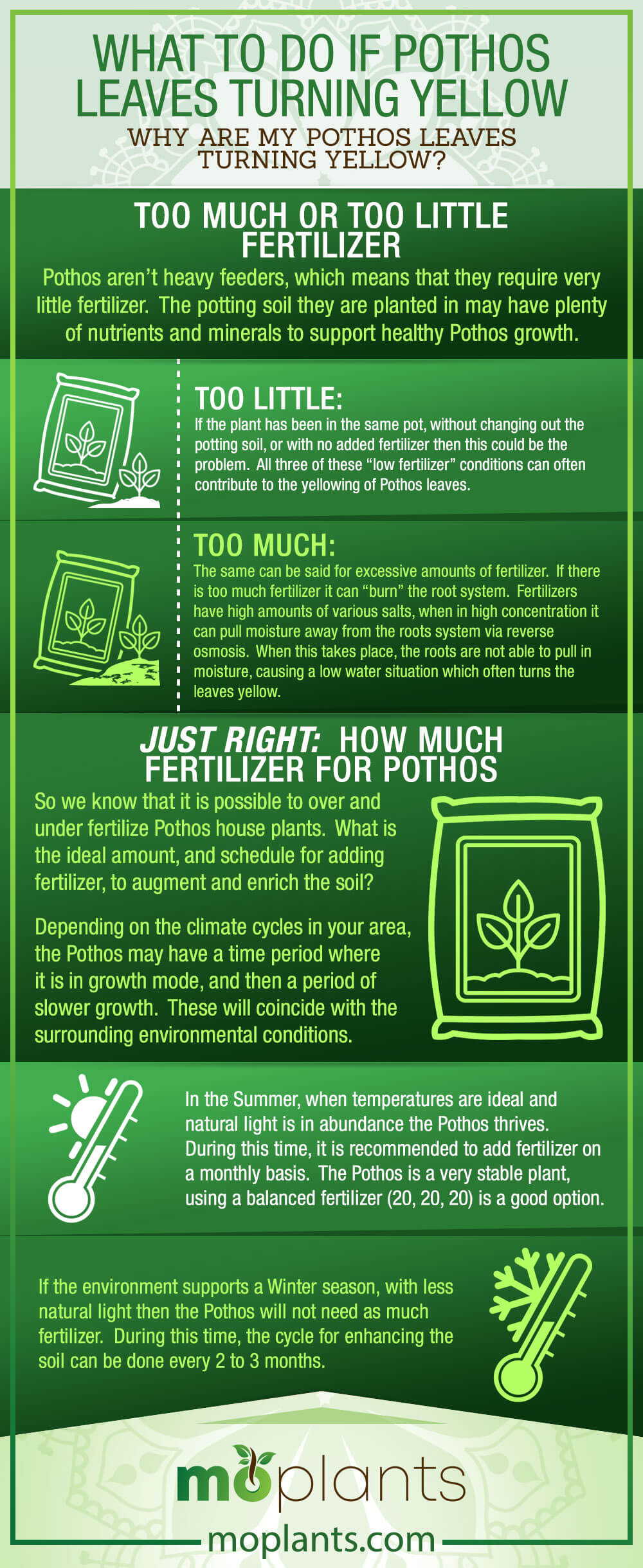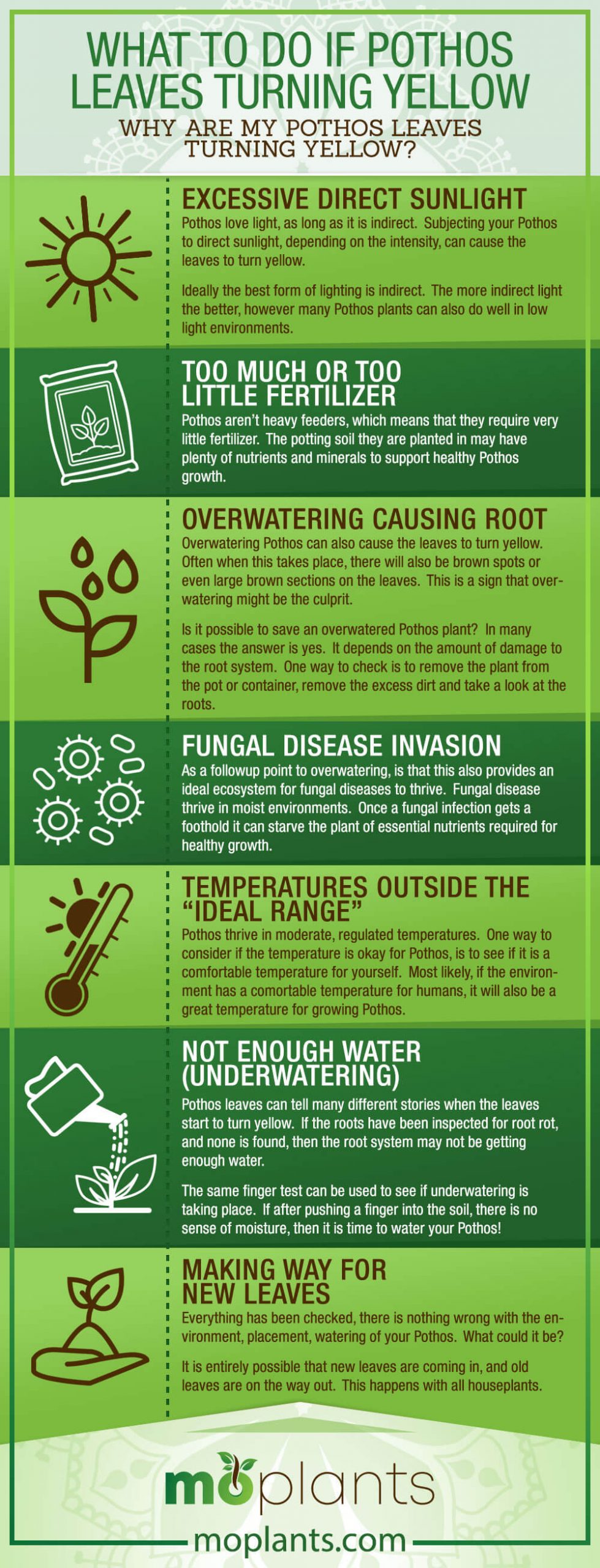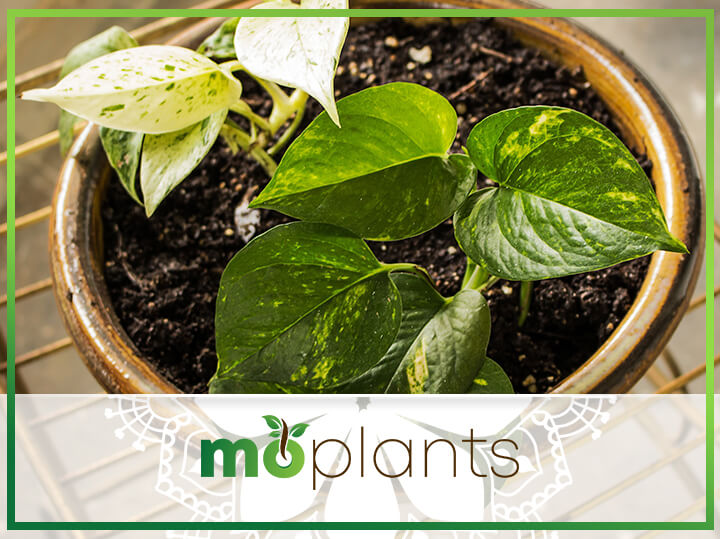Many people love Pothos as a house plant because it is easy to grow and requires minimal maintenance. If your Pothos leaves start turning yellow, you might wonder what on earth is wrong with it! This article will explain why this happens, how to fix it and how to prevent yellow leaves in the first place.
Why are my Pothos leaves turning yellow?
Yellow leaves on a Pothos can be due to:
- Excessive direct sunlight
- Too much or too little fertilizer
- Overwatering causing root rot
- Fungal disease invasion
- Temperatures outside the “ideal range”
- Not enough water (underwatering)
- Making way for new leaves
The good news is that even if your Pothos has yellow leaves, you can revive it by identifying and fixing the cause of the problem. Below we’ll discuss the reasons why Pothos plants get yellow leaves and what you can do to help your beloved plant.
1. Excessive Direct Sunlight
Pothos love light, as long as it is indirect. Subjecting your Pothos to direct sunlight, depending on the intensity, can cause the leaves to turn yellow.
Ideally the best form of lighting is indirect. The more indirect light the better, however many Pothos plants can also do well in low light environments.
If growing indoors, it is quite easy to control the lighting environment. Placing the plant close to a window or a skylight is ideal, just remember that direct sunlight may cause problems. If for short periods of time the plant should be fine. However, if the leaves start to turn yellow it is always recommended to reposition the Pothos plant so it is not exposed to the direct sunlight.
Pothos does well growing outdoors as well. While growing outdoors, it will do the best in a shaded area. If planted in a pot, position it in the shade as much as possible.
2. Too Much or Too Little Fertilizer
Pothos aren’t heavy feeders, which means that they require very little fertilizer. The potting soil they are planted in may have plenty of nutrients and minerals to support healthy Pothos growth.
Too Little:
If the plant has been in the same pot, without changing out the potting soil, or with no added fertilizer then this could be the problem. All three of these “low fertilizer” conditions can often contribute to the yellowing of Pothos leaves.
Too Much:
The same can be said for excessive amounts of fertilizer. If there is too much fertilizer it can “burn” the root system. Fertilizers have high amounts of various salts, when in high concentration it can pull moisture away from the roots system via reverse osmosis. When this takes place, the roots are not able to pull in moisture, causing a low water situation which often turns the leaves yellow.
Just Right: How Much Fertilizer for Pothos
So we know that it is possible to over and under fertilize Pothos house plants. What is the ideal amount, and schedule for adding fertilizer, to augment and enrich the soil?
Depending on the climate cycles in your area, the Pothos may have a time period where it is in growth mode, and then a period of slower growth. These will coincide with the surrounding environmental conditions.
In the Summer, when temperatures are ideal and natural light is in abundance the Pothos thrives. During this time, it is recommended to add fertilizer on a monthly basis. The Pothos is a very stable plant, using a balanced fertilizer (20, 20, 20) is a good option.
If the environment supports a Winter season, with less natural light then the Pothos will not need as much fertilizer. During this time, the cycle for enhancing the soil can be done every 2 to 3 months.
Infographic

3. Overwatering Causing Root Rot
Overwatering Pothos can also cause the leaves to turn yellow. Often when this takes place, there will also be brown spots or even large brown sections on the leaves. This is a sign that overwatering might be the culprit.
Is it possible to save an overwatered Pothos plant? In many cases the answer is yes. It depends on the amount of damage to the root system. One way to check is to remove the plant from the pot or container, remove the excess dirt and take a look at the roots.
If the roots are white, and firm, then they are still in good shape. Overwatering damage to roots typically results in brown and soft roots. These are both telltale signs of root rot.
Once it has been determined that root rot is present, the recommended course of action is to remove the affected roots from the plant. This will leave just the healthy roots, and when repotted, will give the plant the best chance for survival.
Root rot has a direct impact on Pothos plants. It limits the amount of water and nutrients can be absorbed by the roots. This lack of fluids, and necessary nutrients is what causes the leaves to start turning yellow.
Proper watering will prevent this from happening. The amount of water that Pothos need can change based on many factors. Temperature and humidity are two important factors that can affect watering schedules. To make sure overwatering doesn’t happen, push a finger into the soil to test for moisture.
If it feels dry, then it is safe to add water to the plant. When watering let the water flow into the saucer under the pot, and then pour out the excess water. Leaving this standing water can also contribute to root rot.
4. Fungal Disease Invasion
As a followup point to overwatering, is that this also provides an ideal ecosystem for fungal diseases to thrive. Fungal disease thrive in moist environments. Once a fungal infection gets a foothold it can starve the plant of essential nutrients required for healthy growth.
To minimize the chance of a fungal infection taking place, follow the guidelines above on how to best water Pothos.
5. Temperatures Outside the “Ideal Range”
Pothos thrive in moderate, regulated temperatures. One way to consider if the temperature is okay for Pothos, is to see if it is a comfortable temperature for yourself. Most likely, if the environment has a comortable temperature for humans, it will also be a great temperature for growing Pothos.
Typical temperatures where Pothos do well, are in the 70°F to 90°F range. Pothos are fairly hardy, and can handle some temperature fluctuations on either side of this ideal range. Repeated or long term exposure to temperatures outside this range can lead to yellowing of leaves, or worse!
A couple areas inside the home that might push the boundaries of the desired temperature range is having the Pothos too close to a fireplace, heater, window, or heating/cooling vent.
6. Not Enough Water (Underwatering)
Pothos leaves can tell many different stories when the leaves start to turn yellow. If the roots have been inspected for root rot, and none is found, then the root system may not be getting enough water.
The same finger test can be used to see if underwatering is taking place. If after pushing a finger into the soil, there is no sense of moisture, then it is time to water your Pothos!
To prevent this from happening, set a schdule to check all houseplants for moisture. Do it every Monday morning, or Saturday afternoon. Set a schedule that is easy to follow, your plants will thank you for it!
7. Making Way For New Leaves
Everything has been checked, there is nothing wrong with the environment, placement, watering of your Pothos. What could it be?
It is entirely possible that new leaves are coming in, and old leaves are on the way out. This happens with all houseplants.
It is prudent to be aware of what could be causing yellowing of leaves for Pothos plants, it is also good to know that this is something that happens even when all conditions are perfect.
If the leaves turning yellow, and then falling off are older leaves then most likely it is simply Pothos shedding old leaves.
Infographic

Conclusion
Now that you know all the different things to avoid when caring for Pothos plants, growing a healthy Pothos full of shiny, green leaves should be easy peazy!
Please share how this helped Pothos in your house, leave a comment below.

